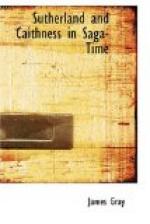“On Monday King Hakon sailed out of the Goa-fiord and let the Scottish man be put on shore, and gave him peace."[19]
Such is the story, so far as Sutherland and Caithness are concerned, of Hakon’s expedition as told in his Saga, which adds that after losing one ship in the Pentland Firth, while another was all but sunk in the Swelchie near Stroma, he sheltered for the night in the Sound north of Osmundwall, and finally landed again near Ragnvaldsvoe and went to Kirkwall. Retaining twenty of his ships, he let such of the rest of them as had not already gone home sail for Norway.
Deserted by his Jarl, the aged king found a home in the Palace of the faithful bishop, Henry of Orkney, who, alone of all Orkney men, had followed the fortunes of the fleet. Then King Hakon’s health gradually failed, and after laying up his ships in Scapa Flow, and seeing to the welfare of his men, he lay down to die of a broken heart, listening as he sank to Masses indeed, but afterwards with greater joy to the Sagas of the Norse kings. “Near midnight” on the 15th of December “Sverri’s Saga was read through. But just as midnight was past Almighty God called King Hakon from this world’s life.”
His body lay in state, first in the Palace and then in the Cathedral of St. Magnus, where after a Solemn Mass it was temporarily buried in the Choir, and it was removed in his flag-ship to Christ Church in Bergen three months afterwards.[20]
The consequence of King Hakon’s failure was the immediate conquest of the Isle of Man and of the Hebrides by Alexander III.
Sutherland and Caithness were saved for Scotland, it would seem, only by the vote of King Hakon’s freemen before sailing for Largs, while the defeat of his fleet there led directly to the cession by King Magnus, his successor, under the treaty of Perth in 1266, of all the Western Highlands and Islands, for a payment of 4000 marks down and of 100 marks a year, and the treaty also secured their permanent political union with Scotland.
Orkney and Shetland, however, remained part of Norway for two hundred years more, and have since 1468 been held by Scotland and afterwards by the United Kingdom only under a wadset or mortgage securing 58,000 crowns, the unpaid balance of the dower of Margaret, wife of James III of Scotland and daughter of King Christian of Norway. The right to redeem them was frequently though fruitlessly claimed by Norway and Denmark in succession until the reign of Charles II and even later; and possibly this right remains, to the legal mind, open until the present day.




